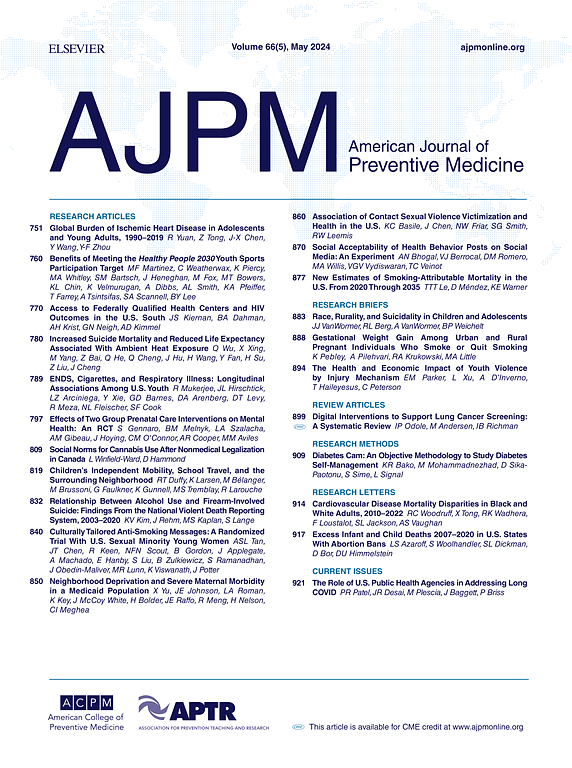Early Childhood Vaccination Coverage and Patterns by Rural–Urban Commuting Area
IF 4.3
2区 医学
Q1 MEDICINE, GENERAL & INTERNAL
引用次数: 0
Abstract
Introduction
National surveillance efforts have reported rural–urban disparities in childhood vaccination coverage by metropolitan statistical area designations, measured at the county level. This study's objective was to quantify vaccination trends using more discrete measures of coverage and rurality than prior work.
Methods
Serial, cross-sectional analyses of National Immunization Survey-Child restricted-use data collected in 2015–2021 for U.S. children born 2014–2018 were conducted. ZIP code of residence was merged with rural–urban commuting area codes. Vaccination coverage and patterns, including on-time receipt of recommended vaccines, were assessed using vaccinations recorded from birth through age 23 months. To determine whether trends differed by rurality, an interaction between birth year and RUCA was tested in multivariable regression models. Analyses were conducted in November 2023-January 2024.
Results
In nationally representative analyses of N=59,361 children, 87.7%, 7.1%, and 5.3% lived in urban, large rural, or small town/rural areas, respectively. Among children born in 2018, coverage for the combined 7-vaccine series was 71.2% (95% CI=69.6%, 72.9%) in urban, 64.9% (95% CI=58.8%, 71.0%) in large rural, and 62.6% (95% CI=56.2%, 68.9%) in small town/rural areas. There was a positive trend in on-time vaccination in urban areas (adjusted prevalence ratio [aPR] for birth year=1.06; 95% CI=1.05, 1.08). While the trend did not significantly differ for large rural versus urban areas (interaction aPR=1.02; 95% CI=0.96, 1.08), there was less improvement in on-time vaccination in small town/rural areas (interaction aPR=0.93; 95% CI=0.88, 0.99).
Conclusions
Increased efforts are needed to eliminate disparities in routine and on-time vaccination for rural children.
按城乡通勤地区划分的幼儿免疫接种覆盖率和模式。
国家监测工作报告了在县一级按大都市统计区指定衡量的儿童疫苗接种覆盖率的城乡差异。本研究的目的是使用比以前工作更离散的覆盖率和农村性措施来量化疫苗接种趋势。方法:对2014-2018年出生的美国儿童进行2015-2021年国家免疫调查儿童限制使用数据的连续横断面分析。居住地的邮政编码与城乡通勤区(RUCA)编码合并。利用从出生到23个月的疫苗接种记录,评估了疫苗接种覆盖率和模式,包括推荐疫苗的按时收到情况。为了确定趋势是否因乡村性而不同,在多变量回归模型中检验了出生年份和RUCA之间的相互作用。分析于2023年11月至2024年1月进行。结果:在对n=59,361名儿童的全国代表性分析中,分别有87.7%、7.1%和5.3%的儿童生活在城市、农村或小城镇/农村地区。在2018年出生的儿童中,7种联合疫苗系列的覆盖率在城市为71.2% (95% CI: 69.6%-72.9%),在大型农村为64.9% (95% CI: 58.8%-71.0%),在小城镇/农村地区为62.6% (95% CI: 56.2%-68.9%)。城市地区准时接种疫苗呈积极趋势(出生年份调整患病率[aPR] =1.06, 95% CI: 1.05-1.08)。虽然大农村地区与城市地区的趋势没有显著差异(相互作用aPR: 1.02, 95% CI: 0.96-1.08),但小城镇/农村地区按时接种疫苗的改善较小(相互作用aPR: 0.93, 95% CI: 0.88-0.99)。结论:需要加大努力消除农村儿童常规和按时接种疫苗的差距。
本文章由计算机程序翻译,如有差异,请以英文原文为准。
求助全文
约1分钟内获得全文
求助全文
来源期刊

American Journal of Preventive Medicine
医学-公共卫生、环境卫生与职业卫生
CiteScore
8.60
自引率
1.80%
发文量
395
审稿时长
32 days
期刊介绍:
The American Journal of Preventive Medicine is the official journal of the American College of Preventive Medicine and the Association for Prevention Teaching and Research. It publishes articles in the areas of prevention research, teaching, practice and policy. Original research is published on interventions aimed at the prevention of chronic and acute disease and the promotion of individual and community health.
Of particular emphasis are papers that address the primary and secondary prevention of important clinical, behavioral and public health issues such as injury and violence, infectious disease, women''s health, smoking, sedentary behaviors and physical activity, nutrition, diabetes, obesity, and substance use disorders. Papers also address educational initiatives aimed at improving the ability of health professionals to provide effective clinical prevention and public health services. Papers on health services research pertinent to prevention and public health are also published. The journal also publishes official policy statements from the two co-sponsoring organizations, review articles, media reviews, and editorials. Finally, the journal periodically publishes supplements and special theme issues devoted to areas of current interest to the prevention community.
 求助内容:
求助内容: 应助结果提醒方式:
应助结果提醒方式:


